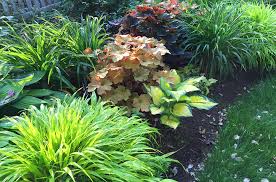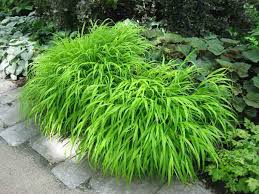Hakone Grass, also known as Japanese forest grass, is a beautiful plant that grows low to the ground in gardens. It has soft, arching leaves that look like cascading waterfalls. This grass is native to Japan and is loved for its calming and serene appearance.
Hakone Grass is a great choice for gardens because it adds a touch of elegance and tranquility. Its leaves are usually green or sometimes golden in color, creating a soothing atmosphere. People often use it in shady spots where other plants might not thrive as well. This grass prefers moist soil and shade, so it’s perfect for areas that don’t get too much sun.
One special thing about Hakone Grass is that it moves gracefully with the wind, creating a gentle swaying motion that adds life to the garden. It’s like nature’s own dance. You can plant it along paths, near water features, or in rock gardens to make your outdoor space more peaceful and inviting.
Taking care of Hakone Grass is easy too. Just make sure to water it regularly, especially during dry spells. You can also trim it in the spring to encourage new growth. With a little bit of attention, this lovely grass will keep delighting you year after year.
In summary, Hakone Grass is a wonderful plant that brings a sense of calm and beauty to gardens. Its graceful leaves, easy care, and preference for shade make it a popular choice for creating a peaceful outdoor retreat. So, if you’re looking to add a touch of elegance to your garden, consider planting some Hakone Grass.
Read Also: How to Grow Paw-Paw (papayas): Beginners Business Guide
Growing and Care Guide of Hakone Grass

Here’s a simple growing and care guide for Hakone Grass:
Growing Hakone Grass
1. Choose the Right Spot: Pick a spot in your garden that receives partial to full shade. Hakone Grass thrives in areas with filtered sunlight and moist soil.
2. Prepare the Soil: Make sure the soil is well-draining and rich in organic matter. You can add compost or well-rotted manure to improve soil quality.
3. Planting: Plant Hakone Grass in spring or fall. Dig a hole slightly larger than the root ball and place the plant in it. Fill the hole with soil and gently pat it down around the plant.
4. Spacing: Space the plants about 12 to 18 inches apart to allow them room to spread and grow.
Care Tips
1. Watering: Keep the soil consistently moist, especially during the growing season. Water deeply to ensure the roots receive enough moisture. Avoid letting the soil dry out completely.
2. Mulching: Apply a layer of organic mulch around the plants to help retain moisture, regulate soil temperature, and prevent weed growth.
3. Fertilizing: Hakone Grass doesn’t require heavy feeding. You can apply a balanced, slow-release fertilizer in spring as new growth begins.
4. Pruning: In late winter or early spring, trim back the old foliage to make way for new growth. Trim to about 2-3 inches above the ground.
5. Dividing: Over time, Hakone Grass can become crowded. Divide the plants every 3-4 years in early spring to maintain their health and vigor.
6. Pest and Disease: Generally, Hakone Grass is resistant to pests and diseases. However, keep an eye out for snails and slugs, especially in wet conditions.
7. Winter Care: Hakone Grass is hardy, but if you live in a colder climate, a layer of mulch can help protect the roots during winter.
Remember, Hakone Grass is valued for its elegant and calming appearance. Let it sway in the breeze and enjoy its graceful movement in your garden. With a little attention, your Hakone Grass will reward you with its beauty year after year.
Benefits of Hakone Grass
Here are some benefits of having Hakone Grass in your garden:
1. Elegant Aesthetic: Hakone Grass adds a touch of elegance and tranquility to your garden with its gracefully arching leaves. Its gentle movement in the wind creates a soothing and visually pleasing effect.
2. Shade Tolerant: This grass thrives in shaded areas where other plants might struggle. If you have spots in your garden with limited sunlight, Hakone Grass can be a wonderful choice to bring life and greenery to those areas.
3. Low Maintenance: Hakone Grass is relatively low-maintenance once established. It doesn’t require frequent pruning or deadheading, making it a convenient option for busy gardeners.
4. Ground Cover: With its spreading growth habit, Hakone Grass can be used as a ground cover to fill in empty spaces or cover the soil around trees and shrubs. Its lush foliage helps prevent soil erosion.
5. Soothing Atmosphere: The gentle swaying of Hakone Grass in the wind creates a calming atmosphere in your garden. It’s perfect for creating a peaceful retreat where you can unwind and relax.
6. Versatile Use: Whether in rock gardens, along pathways, near water features, or in containers, Hakone Grass can be used in various landscaping designs to enhance the overall beauty of your outdoor space.
7. Natural Privacy: When planted strategically, Hakone Grass can act as a natural screen, providing a sense of privacy while maintaining an open and inviting feel.
8. Drought Tolerance: While it prefers moist soil, once established, Hakone Grass has some tolerance to short periods of drought, making it adaptable to changing weather conditions.
9. Year-Round Interest: Even during winter, the dried foliage of Hakone Grass can provide visual interest in the garden. It adds texture and structure to the landscape during the colder months.
10. Wildlife Habitat: Hakone Grass can attract small wildlife like birds and insects, contributing to a balanced and diverse ecosystem in your garden.
In addition, Hakone Grass offers a range of benefits, from its serene appearance and shade tolerance to its low maintenance and versatile use. It’s a versatile plant that can add a touch of beauty and tranquility to your outdoor space.
Hakonechloa Macra

Hakonechloa macra, also known as Hakone Grass, is a lovely plant that grows close to the ground. It has pretty, drooping leaves that look like flowing water. This plant comes from Japan and is loved for its calm and peaceful look.
Hakonechloa macra is great for gardens. It adds a touch of elegance and calmness. Its leaves are usually green or sometimes golden. This grass likes shady spots where the sun doesn’t shine too much.
One special thing about Hakonechloa macra is how it moves gently with the wind, like it’s dancing. This makes gardens feel alive and soothing. You can plant it along paths, close to water, or in rock gardens. It makes outdoor spaces feel peaceful and welcoming.
Taking care of Hakonechloa macra is easy. Just make sure to water it often, especially when it’s dry outside. You can also trim it in the spring to help it grow nicely. This beautiful grass will keep making you happy year after year.
However, Hakonechloa macra, or Hakone Grass, is a wonderful plant for gardens. Its drooping leaves, simple care, and love for shade make it a popular choice for making gardens feel peaceful. If you want to add a touch of elegance to your garden, think about planting Hakonechloa macra.
Read Also: Planting, Growing and Harvesting Grapes
Container Gardening
Container gardening is a fun and creative way to grow plants in pots or containers instead of directly in the ground. It’s especially useful for people with limited outdoor space, like balconies or patios, or those who want to bring greenery indoors.
Below is how to get started:
1. Choose the Right Container: Pick pots with drainage holes to prevent waterlogging. Containers come in various sizes, materials, and styles. Make sure they match the plants’ needs and your aesthetic preferences.
2. Select Plants: Choose plants that suit your environment and container size. Consider factors like sunlight, temperature, and growth habits. Flowers, herbs, small vegetables, and even dwarf trees can thrive in containers.
3. Potting Mix: Use a high-quality potting mix that provides good drainage and nutrients. Regular garden soil might not be suitable, as it can become compacted in containers.
Planting
1. Fill Containers: Fill the container with potting mix, leaving space at the top for watering. Don’t pack the soil too tightly.
2. Plant Placement: Arrange plants according to their height and growth habits. Taller plants go in the back, while trailing or shorter plants go in the front.
3. Watering: Water thoroughly after planting to help settle the soil. Monitor the soil moisture regularly and water as needed. Containers dry out faster than garden beds, so don’t let them become too dry.
Care Tips
1. Sunlight: Place containers where they receive the right amount of sunlight for the chosen plants. Some need full sun, while others prefer partial or full shade.
2. Fertilizing: Use a balanced liquid fertilizer or slow-release pellets according to the plants’ needs. Follow the recommended dosage on the packaging.
3. Deadheading: Remove spent flowers to encourage more blooms and maintain a tidy appearance.
4. Pruning: Trim back leggy growth or dead leaves to keep the plants looking healthy and vibrant.
5. Pest Control: Keep an eye out for pests and diseases. Inspect plants regularly and address any issues promptly.
6. Rotation: Rotate the containers occasionally to ensure all sides receive sunlight evenly. This prevents plants from leaning towards the light.
7. Support: Some plants might need support as they grow. Use stakes or trellises to keep them upright.
Advantages
1. Flexibility: You can move containers around to find the best light and temperature conditions for your plants.
2. No Yard Required: Container gardening is perfect for people without a yard or for those who want to garden indoors.
3. Control: You have more control over the soil quality, water, and nutrients, leading to healthier plants.
4. Decorative: Containers add a decorative touch to your outdoor or indoor space, allowing you to create personalized plant displays.
5. Easy Maintenance: Container gardens can be easier to manage than large garden beds, making them great for beginners.
Container gardening is a delightful way to express your creativity and enjoy the beauty of plants, even in limited spaces. With proper care, your container garden can thrive and bring nature closer to your home.
Read Also: Everything You Need to Know About Wastewater Treatment Equipment
